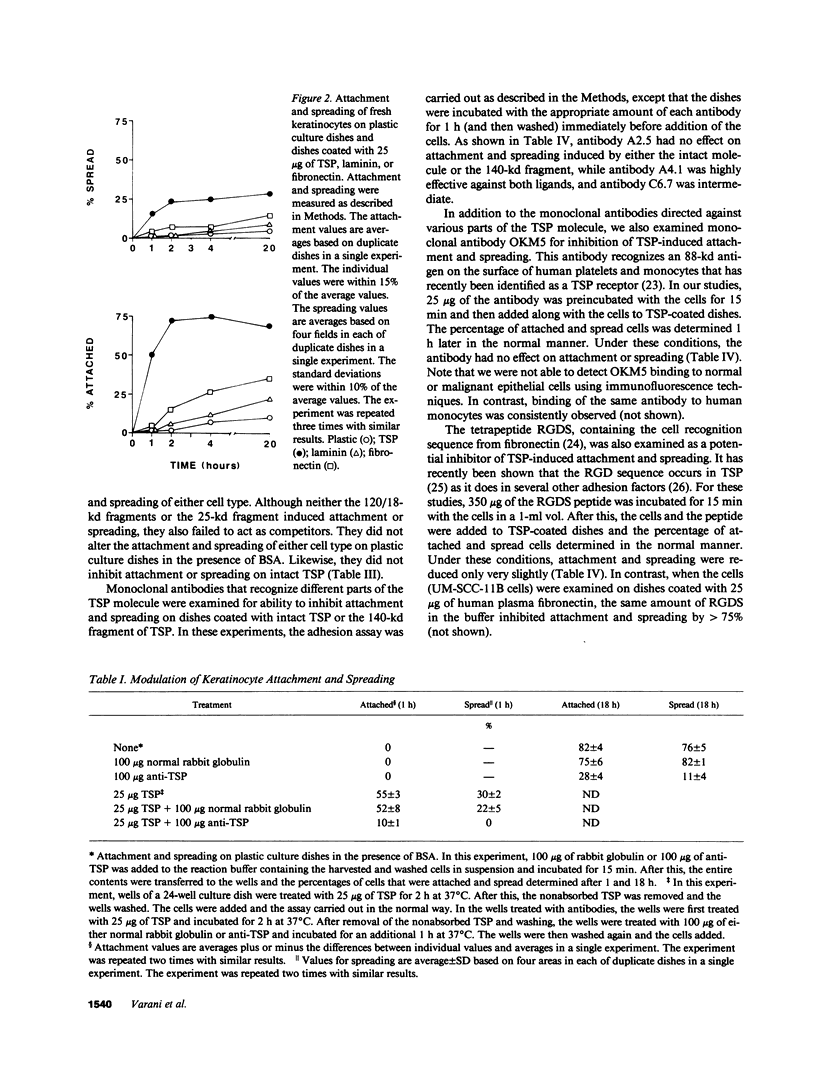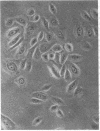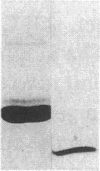Abstract
Human epidermal keratinocytes obtained from normal skin attached and spread on thrombospondin (TSP)-coated plastic dishes but failed to attach and spread on untreated plastic culture dishes or dishes coated with fibronectin or laminin. These cells produced minimal amounts of immunoreactive TSP. Keratinocytes established in culture on MCDB 153 medium and maintained for one to three passages in an undifferentiated state by continued cultivation in this low Ca2+-containing medium attached and spread on plastic dishes as well as on TSP-coated dishes. These cells also secreted significant amounts of TSP into the culture medium. When the keratinocytes were incubated for one day in MCDB 153 medium supplemented with high Ca2+ or in MEM (which also contains high Ca2+), there was decreased secretion of TSP into the culture medium concomitant with a reduction in attachment and spreading on plastic culture dishes. Proteolytic fragments of TSP were examined for stimulation of keratinocyte attachment and spreading. A 140-kd fragment produced by removal of the 25-kd heparin-binding domain had similar activity to the intact molecule while the 25-kd fragment was without effect. Further proteolytic treatment of the 140-kd fragment gave rise to a fragment consisting of 120 kd and 18-D moieties held together in disulphide linkage. This fragment did not support attachment or spreading. This study reveals that normal epidermal keratinocytes grown under conditions that maintain the undifferentiated state are able to produce TSP and utilize it as an attachment factor. When keratinocytes are grown under conditions that promote differentiation, ability to produce and utilize TSP is diminished. Since TSP is present at the dermal-epidermal junction and because TSP promotes keratinocyte attachment and spreading, this molecule may play an important role in maintaining normal growth of the basal cell layer and may also participate in reepithelialization during wound repair.
Full text
PDF







Images in this article
Selected References
These references are in PubMed. This may not be the complete list of references from this article.
- Asch A. S., Barnwell J., Silverstein R. L., Nachman R. L. Isolation of the thrombospondin membrane receptor. J Clin Invest. 1987 Apr;79(4):1054–1061. doi: 10.1172/JCI112918. [DOI] [PMC free article] [PubMed] [Google Scholar]
- Baenziger N. L., Brodie G. N., Majerus P. W. A thrombin-sensitive protein of human platelet membranes. Proc Natl Acad Sci U S A. 1971 Jan;68(1):240–243. doi: 10.1073/pnas.68.1.240. [DOI] [PMC free article] [PubMed] [Google Scholar]
- Baenziger N. L., Brodie G. N., Majerus P. W. Isolation and properties of a thrombin-sensitive protein of human platelets. J Biol Chem. 1972 May 10;247(9):2723–2731. [PubMed] [Google Scholar]
- Bober F. J., Birk D. E., Raska K., Jr Expression of varying portions of the adenovirus 12 early region 1 in transformed cells affects tumorigenicity and interaction with extracellular matrix components. Lab Invest. 1987 Jan;56(1):37–43. [PubMed] [Google Scholar]
- Boyce S. T., Ham R. G. Calcium-regulated differentiation of normal human epidermal keratinocytes in chemically defined clonal culture and serum-free serial culture. J Invest Dermatol. 1983 Jul;81(1 Suppl):33s–40s. doi: 10.1111/1523-1747.ep12540422. [DOI] [PubMed] [Google Scholar]
- Clark R. A., Folkvord J. M., Wertz R. L. Fibronectin, as well as other extracellular matrix proteins, mediate human keratinocyte adherence. J Invest Dermatol. 1985 May;84(5):378–383. doi: 10.1111/1523-1747.ep12265466. [DOI] [PubMed] [Google Scholar]
- Clark R. A., Nielsen L. D., Howell S. E., Folkvord J. M. Human keratinocytes that have not terminally differentiated synthesize laminin and fibronectin but deposit only fibronectin in the pericellular matrix. J Cell Biochem. 1985;28(2):127–141. doi: 10.1002/jcb.240280206. [DOI] [PubMed] [Google Scholar]
- Dixit V. M., Haverstick D. M., O'Rourke K. M., Hennessy S. W., Grant G. A., Santoro S. A., Frazier W. A. A monoclonal antibody against human thrombospondin inhibits platelet aggregation. Proc Natl Acad Sci U S A. 1985 May;82(10):3472–3476. doi: 10.1073/pnas.82.10.3472. [DOI] [PMC free article] [PubMed] [Google Scholar]
- Dixit V. M., Haverstick D. M., O'Rourke K. M., Hennessy S. W., Grant G. A., Santoro S. A., Frazier W. A. Effects of anti-thrombospondin monoclonal antibodies on the agglutination of erythrocytes and fixed, activated platelets by purified thrombospondin. Biochemistry. 1985 Jul 30;24(16):4270–4275. doi: 10.1021/bi00337a003. [DOI] [PubMed] [Google Scholar]
- Galvin N. J., Dixit V. M., O'Rourke K. M., Santoro S. A., Grant G. A., Frazier W. A. Mapping of epitopes for monoclonal antibodies against human platelet thrombospondin with electron microscopy and high sensitivity amino acid sequencing. J Cell Biol. 1985 Oct;101(4):1434–1441. doi: 10.1083/jcb.101.4.1434. [DOI] [PMC free article] [PubMed] [Google Scholar]
- Jaffe E. A., Ruggiero J. T., Leung L. K., Doyle M. J., McKeown-Longo P. J., Mosher D. F. Cultured human fibroblasts synthesize and secrete thrombospondin and incorporate it into extracellular matrix. Proc Natl Acad Sci U S A. 1983 Feb;80(4):998–1002. doi: 10.1073/pnas.80.4.998. [DOI] [PMC free article] [PubMed] [Google Scholar]
- LOWRY O. H., ROSEBROUGH N. J., FARR A. L., RANDALL R. J. Protein measurement with the Folin phenol reagent. J Biol Chem. 1951 Nov;193(1):265–275. [PubMed] [Google Scholar]
- Lawler J., Hynes R. O. The structure of human thrombospondin, an adhesive glycoprotein with multiple calcium-binding sites and homologies with several different proteins. J Cell Biol. 1986 Nov;103(5):1635–1648. doi: 10.1083/jcb.103.5.1635. [DOI] [PMC free article] [PubMed] [Google Scholar]
- Liu S. C., Karasek M. Isolation and growth of adult human epidermal keratinocytes in cell culture. J Invest Dermatol. 1978 Aug;71(2):157–162. doi: 10.1111/1523-1747.ep12546943. [DOI] [PubMed] [Google Scholar]
- McPherson J., Sage H., Bornstein P. Isolation and characterization of a glycoprotein secreted by aortic endothelial cells in culture. Apparent identity with platelet thrombospondin. J Biol Chem. 1981 Nov 10;256(21):11330–11336. [PubMed] [Google Scholar]
- Mosher D. F., Doyle M. J., Jaffe E. A. Synthesis and secretion of thrombospondin by cultured human endothelial cells. J Cell Biol. 1982 May;93(2):343–348. doi: 10.1083/jcb.93.2.343. [DOI] [PMC free article] [PubMed] [Google Scholar]
- Nickoloff B. J., Basham T. Y., Merigan T. C., Morhenn V. B. Antiproliferative effects of recombinant alpha- and gamma-interferons on cultured human keratinocytes. Lab Invest. 1984 Dec;51(6):697–701. [PubMed] [Google Scholar]
- Pierschbacher M. D., Hayman E. G., Ruoslahti E. The cell attachment determinant in fibronectin. J Cell Biochem. 1985;28(2):115–126. doi: 10.1002/jcb.240280205. [DOI] [PubMed] [Google Scholar]
- Pierschbacher M. D., Ruoslahti E. Cell attachment activity of fibronectin can be duplicated by small synthetic fragments of the molecule. Nature. 1984 May 3;309(5963):30–33. doi: 10.1038/309030a0. [DOI] [PubMed] [Google Scholar]
- Rampoldi E., Larizza L., Doneda L., Barlati S. Fibronectin, laminin in hybrids of Rous sarcoma virus transformed and normal mouse fibroblasts. Tumori. 1985 Oct 31;71(5):419–423. doi: 10.1177/030089168507100502. [DOI] [PubMed] [Google Scholar]
- Raugi G. J., Mumby S. M., Abbott-Brown D., Bornstein P. Thrombospondin: synthesis and secretion by cells in culture. J Cell Biol. 1982 Oct;95(1):351–354. doi: 10.1083/jcb.95.1.351. [DOI] [PMC free article] [PubMed] [Google Scholar]
- Roberts D. D., Sherwood J. A., Ginsburg V. Platelet thrombospondin mediates attachment and spreading of human melanoma cells. J Cell Biol. 1987 Jan;104(1):131–139. doi: 10.1083/jcb.104.1.131. [DOI] [PMC free article] [PubMed] [Google Scholar]
- Sage H., Farin F. M., Striker G. E., Fisher A. B. Granular pneumocytes in primary culture secrete several major components of the extracellular matrix. Biochemistry. 1983 Apr 26;22(9):2148–2155. doi: 10.1021/bi00278a015. [DOI] [PubMed] [Google Scholar]
- Timpl R., Rohde H., Robey P. G., Rennard S. I., Foidart J. M., Martin G. R. Laminin--a glycoprotein from basement membranes. J Biol Chem. 1979 Oct 10;254(19):9933–9937. [PubMed] [Google Scholar]
- Toda K., Grinnell F. Activation of human keratinocyte fibronectin receptor function in relation to other ligand-receptor interactions. J Invest Dermatol. 1987 Apr;88(4):412–417. doi: 10.1111/1523-1747.ep12469745. [DOI] [PubMed] [Google Scholar]
- Varani J., Carey T. E., Fligiel S. E., McKeever P. E., Dixit V. Tumor type-specific differences in cell-substrate adhesion among human tumor cell lines. Int J Cancer. 1987 Mar 15;39(3):397–403. doi: 10.1002/ijc.2910390321. [DOI] [PubMed] [Google Scholar]
- Varani J., Dixit V. M., Fligiel S. E., McKeever P. E., Carey T. E. Thrombospondin-induced attachment and spreading of human squamous carcinoma cells. Exp Cell Res. 1986 Dec;167(2):376–390. doi: 10.1016/0014-4827(86)90178-3. [DOI] [PubMed] [Google Scholar]
- Varani J., Grimstad I. A., Knibbs R. N., Hovig T., McCoy J. P. Attachment, spreading and growth in vitro of highly malignant and low malignant murine fibrosarcoma cells. Clin Exp Metastasis. 1985 Jan-Mar;3(1):45–59. doi: 10.1007/BF01758953. [DOI] [PubMed] [Google Scholar]
- Varani J., Lovett E. J., 3rd, McCoy J. P., Jr, Shibata S., Maddox D. E., Goldstein I. J., Wicha M. Differential expression of a lamininlike substance by high- and low-metastatic tumor cells. Am J Pathol. 1983 Apr;111(1):27–34. [PMC free article] [PubMed] [Google Scholar]
- Wight T. N., Raugi G. J., Mumby S. M., Bornstein P. Light microscopic immunolocation of thrombospondin in human tissues. J Histochem Cytochem. 1985 Apr;33(4):295–302. doi: 10.1177/33.4.3884704. [DOI] [PubMed] [Google Scholar]
- Wikner N. E., Dixit V. M., Frazier W. A., Clark R. A. Human keratinocytes synthesize and secrete the extracellular matrix protein, thrombospondin. J Invest Dermatol. 1987 Feb;88(2):207–211. doi: 10.1111/1523-1747.ep12525350. [DOI] [PubMed] [Google Scholar]
- Woodley D. T., O'Keefe E. J., Prunieras M. Cutaneous wound healing: a model for cell-matrix interactions. J Am Acad Dermatol. 1985 Feb;12(2 Pt 2):420–433. doi: 10.1016/s0190-9622(85)80005-0. [DOI] [PubMed] [Google Scholar]








